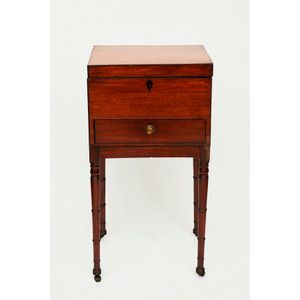Victorian Cedar Desk with Leather Top and Drawers
A Victorian cedar desk, 19th century, the maroon leather topped table desk with two half width frieze drawers and raised on slender baluster and turned legs terminating in brass casters; as found. Height 81 cm. Width 152 cm. Depth 92 cm
You must be a subscriber, and be logged in to view price and dealer details.
Subscribe Now to view actual auction price for this item
When you subscribe, you have the option of setting the currency in which to display prices to $Au, $US, $NZ or Stg.
This item has been sold, and the description, image and price are for reference purposes only.
- Frieze - An architectural term denoting the flat, shaped or convex horizontal surface of furniture, between the architrave and the cornice, usually found on a cabinet or bookcase, or on desks and tables where it may include drawers, the area between the top and the legs. In ceramics, the term refers to the banding, of usually a repeating pattern, on the rims of plates and vases.
- Turned Legs - are legs which have been turned on a lathe. In use from the 16th century, turned legs on tables, chairs and cabinets became more frequent until, by the 1830s, the Georgian square or tapered leg was rarely found except in country pieces.
- Baluster (furniture) - An architectural term for a column in a balustrade or staircase, often defined as a "vase shape". The shape is extensively used in furniture and decorative arts.
In furniture, it is used to describe a chair or table leg turned in that form, or more usually as an inverted baluster, with the bulbous section to the top. Less commonly used to describe a chair back that has the outline of a baluster. A baluster may also be split and applied to the front of a cupboard for ornamentation.
For ceramics and silver items it is often used to describe the shape of the whole item, rather than a part.
In Georgian glassware, the shape is commonly seen in the stem of glasses. - Victorian Period - The Victorian period of furniture and decorative arts design covers the reign of Queen Victoria from 1837 to 1901. There was not one dominant style of furniture in the Victorian period. Designers used and modified many historical styles such as Gothic, Tudor, Elizabethan, English Rococo, Neoclassical and others, although use of some styles, such as English Rococo and Gothic tended to dominate the furniture manufacture of the period.
The Victorian period was preceded by the Regency and William IV periods, and followed by the Edwardian period, named for Edward VII (1841 ? 1910) who was King of the United Kingdom and the British Dominions and Emperor of India for the brief period from 1901 until his death in 1910. - Turning - Any part of a piece of furniture that has been turned and shaped with chisels on a lathe. Turned sections include legs, columns, feet, finials, pedestals, stretchers, spindles etc. There have been many varieties and fashions over the centuries: baluster, melon, barley-sugar, bobbin, cotton-reel, rope-twist, and so on. Split turning implies a turned section that has been cut in half lengthwise and applied to a cabinet front as a false decorative support.
This item has been included into following indexes:
-
desks, material
- cedar, large 43
- cedar, small 43
- desks, period or age - Victorian 409
Visually similar items

19th century cedar three drawer desk on turned legs
Sold by
in
for
You can display prices in $Au, $US, $NZ or Stg.

A Georgian mahogany sideboard, with a shaped rectangular top, above two bowed side doors and two central drawers, turned supports, 182.5 x 92 x 67 cm
Sold by
in
for
You can display prices in $Au, $US, $NZ or Stg.

Mahogany tea caddy on stand, the rectangular box with ebony string inlay, one drawer below, on four turned legs, height 70.5 cm, width 35 cm, depth 25.5 cm
Sold by
in
for
You can display prices in $Au, $US, $NZ or Stg.

A George III style Dresser base, 20th century
Sold by
in
for
You can display prices in $Au, $US, $NZ or Stg.
